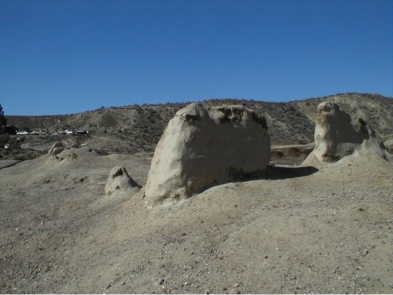
By David Kier
www.vivabaja.com
Co-author of ‘The Old Missions of Baja & Alta California, 1697-1834’
El Rosario was the first California mission founded by the Dominican Order, just one year after assuming responsibility over a dozen Jesuit founded missions, and one founded by the Franciscans. The site for El Rosario was known to the Cochimí Indians as Viñadaco (also spelled Viñaraco or Viñatacót). The valley was investigated by Dominican President Padre Vicente Mora in late 1773. He found fresh water pools and after digging some wells, tapped into a flowing spring of water. No better location for a mission was found than this one at Viñadaco.
The documents providing the exact founding date and priest are lost, but a marriage was performed on July 21, 1774 by Padre Francisco Galisteo. Padre Galisteo also wrote that the Burial Register begins on July 24, 1774 (the first entry was not until January 3, 1775).
Padre Galisteo served at El Rosario until the end of 1779. However, he had assistance from Padres Manuel Hidalgo, Manuel Perez, José Aivar, and Pedro Gandiaga. Padre Luis Sales also performed baptisms in 1778. Padre Sales was the only Dominican to have his letters published into a book, ‘Observations on California, 1772-1790’. Padre Perez was the resident missionary from 1779 until Perez died in March, 1788. Who immediately replaced Perez as resident is unclear, but several Dominicans have entered their names into the books.
In 1790, Padre Luis Sales wrote the following:
“In the year 1774 we were given an order to explore some territories in which to found new settlements and to establish the conquest of the heathen, and this in spite of the fact that the Franciscans had explored the locations indicated by the King and reported them as useless. Nevertheless, whether because of rains or the freshets of the arroyos, or other circumstances which I omit, a place with many heathen, called Viñatacót, was found, which served for the foundation of a mission named Nuestra Señora del Rosario, and it has turned out so prosperous that today it is one of the richest settlements, supplying much grain to maintain the neighboring Indians.”
Padre Vicente Belda became the resident missionary from December 28, 1792 until August 9, 1798. Padre Juan Ribas was the next resident padre to mid 1802. Ribas was replaced at El Rosario by Padre Raymundo Escola until 1807. Padre José Cauas replaced Escola until mid 1814. A few more Dominicans took turns entering baptisms to the year 1828 before a 13 year gap in entries. This long absence was ended with the October 4, 1844 additions by Padre Thomas Mansilla for three baptisms, entered as # 1447-1449.
A report in 1793 describes the church, made of adobe 130 feet by 25 feet in size. There was also an adobe room for the priests to reside in. An adobe room 22 feet long was added in 1798. In 1800, four adobe rooms were added to be used for storage, kitchen, weaving, and a forge.
The neophyte population numbers at El Rosario was reported as being 564 in 1776, after which epidemics took their toll dropping the population to 251 in 1782. An increase to 390 was reported in 1793, then a drop to 257 in 1800, 199 in 1808, and just 38 in 1829.
In 1802 the mission was moved two miles west and closer to the river, after the spring dried up at the first site. One story says it was buried by a flood-caused landslide. The first site is locally referred to as El Rosario de Arriba (Upper Rosario) and the second site as El Rosario de Abajo (Lower Rosario). The second site had been an Indian ranchería, called San José. A multi-room adobe building was erected there in 1799. The second mission location was not only closer to the river, but closer to the ocean and to more land under cultivation. The new mission church was made of massive earthen walls on a foundation of mortared stones. The doorway was a pointed Gothic arch, something unseen at other California missions built in the same period. The walls were coated with white plaster that would have been brilliant and visible from great distances. The El Rosario mission was perhaps the most stable and successful of the Dominican missions.
The date the mission was closed is unknown, but other writers have listed 1828 to 1832 as being the final year. When Mexican farmers moved into the valley, they made use of the abandoned mission tiles and other coverings for their own homes. The adobe walls became exposed to rain, and have slowly been eroding back to the earth. Efforts to stabilize the remaining walls with a plaster coating as well as installing gravel walkways have been made in recent years at both mission sites.
The first mission site is just north of Highway 1, in the town of El Rosario. Go 0.8 mile from the Pemex gas station and turn uphill, just a few hundred feet. The second site is across the river in the small village of El Rosario de Abajo. Turn right where Highway 1 makes a sharp left curve, just past Mama Espinoza’s restaurant, and then turn left at the next street and cross the river. Head west, going 1.6 miles from Highway 1. The ruins are on the right as you drive through El Rosario de Abajo.
Photos at the first site:
Photos at the second site:
David Kier is co-author of ‘The Old Missions of Baja & Alta California, 1697-1834’. The book is available for purchase HERE or at the DBTC offices (call 800-727-2252).














One thought on “The Spanish Missions on the California Peninsula: #19, Nuestra Señora del Rosario de Viñadaco (1774-1829)”